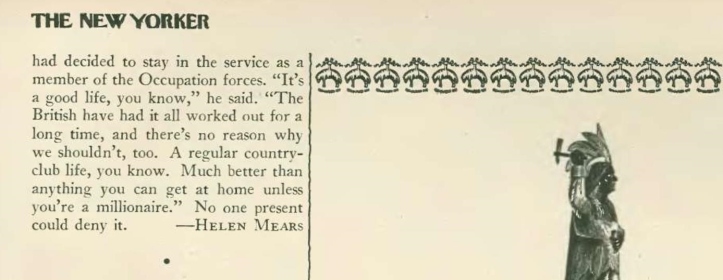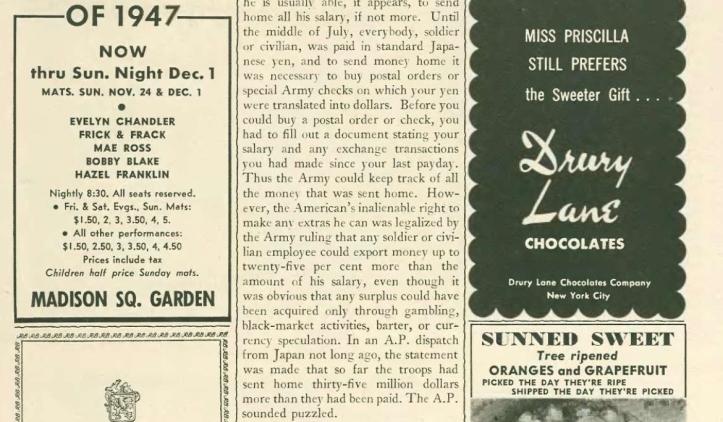The November 23, 1946 issue of The New Yorker ran an article by Helen Mears in their “Our far-flung correspondents” section. Titled “You in Tokyo“, the piece was named after a pamphlet given to new American arrivals that explained things like protocols, customs and recreational activities.
Excerpt from You in Tokyo pamphlet, published by SCAP GHQ for civilian employees of the American occupation of Japan (source):
This short piece provides amusing observations about life as an American occupier, which has similarities to life as an American expat today. For example, Mears describes confusion over English translations of Japanese words (in this case it was the Hepburn System vs. the Nippon System; I personally spent months getting used to the idea that Shinbashi and Shimbashi were the same place).
Mears also describes the mentality of an American who enjoys his life in Japan and is reluctant to leave:
“He had been a poorly paid schoolteacher before the war and he had decided to stay in the service as a member of the Occupation forces. “It’s a good life, you know,” he said. “The British have had it all worked out for a long time, and there’s no reason why we shouldn’t too. A regular country-club life, you know? Much better than anything you can get at home unless you’re a millionaire.” No one present could deny it.”
Also interesting was the description of black market activities that many Americans took part in, and the Army’s tolerance of this activity. Mears notes:
“any soldier or civilian could export money up to twenty-five per cent more than the amount of his salary, even though it was obvious that any surplus could have been acquired only through gambling, black-market activities, barter, or currency speculation.”
Also this quote about trading used clothing for kimonos or ceremonial swords:
“Old hands in the Occupation look upon these exchanges not only as sound finance but as philanthropy. They argue, with sincerity, that since the Japanese need every sort of commodity, it is only fair to sell or barter one’s extras.”
The article touches upon a topic that demands a deeper discussion: the origins and nature of democracy in Japan. The American occupation of Japan was, among other things, a mission of economic reconstruction and social engineering. One major initiative was land reform: approximately 38% of Japan’s cultivated land was redistributed. The introduction of democracy was another major project.
“it was under General Dyke’s direction that the C.I.&E. was built up to a staff of around a hundred people, who are now busy with the “democratization” of the Japanese press, movies, religion, and so on….
…The task includes things like censoring the press and having textbooks rewritten, so it is not too surprising that some of the Japanese say they are not quite sure what we mean by freedom and democracy.”
For further reading on the democratization of Japan, I highly recommend Popcorn on the Ginza: An Informal Portrait of Postwar Japan (1949) by Lucy Herndon Crockett (1914-2002), an amusing and informative first-person account of the Allied Occupation and rebuilding of Japan following World War II. I plan to write about this book in greater detail. In the meantime, here’s a stylish illustration from her book:
Links:
Helen Mears
- Helen Mears’ work for The New Yorker (link) (spans the years 1938 – 1948)
- Jacket from her book, Mirror for Americans (1948)
- Mirror for Americans, Japanese edition: アメリカの鏡・日本 完全版
- Mirror for Americans: Japan Helen Mears (review and excerpt, from Mochi Thinking)


Land reform
- “By 1949, SCAP had forced the Japanese government to redistribute about 2 million hectare of farm land, and 1 million hectares of irrigated paddies. As of 1941, farmers had rented 46 percent of their land. After the SCAP-mandated reform, they rented only 10 percent.” – The Fable of Land Reform: Expropriation and Redistribution in Occupied Japan, by J. Mark Ramseyer
- “Between 1947 and 1949, approximately 5,800,000 acres (23,000 km2) of land (approximately 38% of Japan’s cultivated land) was purchased from the landlords under the reform program and re-sold at extremely low prices (after inflation) to the farmers who worked them. By 1950, three million peasants had acquired land…” – Wikipedia
American Occupation of Japan
- The American Occupation of Japan, 1945-1952 (Asia for Educators, Columbia University)
- Allied Occupation of Japan, by Eiji Takemae
- Made in Occupied Japan: Eikeisha Clock (1947-1952)
- Map of American occupied Tokyo, 1948 GHQ東京占領地図
- Crimes of the Occupation: The Kokura incident, “committing excesses”, and murder on the 4th of July 「黒地の絵」
The New Yorker’s OUR FAR-FLUNG CORRESPONDENTS: selected Japan articles over the years
- OCTOBER 12, 1946: TOKYO REVISITED, by Helen Mears: postwar Tokyo. Among the many strange phenomena are the crowds of Japanese who wait every day outside the Dai Ichi Building.
- FEBRUARY 7, 1948: LIFE WITH THE DAI ITIANS by Helen Mears: tells about what goes on at the Dai Iti Hotel, in Tokyo, one of the largest billets for American officers and civilians.
- THE SUPER-EXPRESS OF DREAMS, by E. J. KAHN: about travelling on a new, fast train between Japan’s two largest cities, Tokyo and Osaka.
- Preble’s Law and Other Matters by CHARLES FRANKEL: modern Japan.
Other American women in Occupation-era Japan
- “Secretary’s Tokyo Career, Wedding Capture Attention” (The Spokesman-Review, August 2, 1959)
Ginza






[…] “You in Tokyo” – THE NEW YORKER, 1946 (and ‘Popcorn on the Ginza’) […]